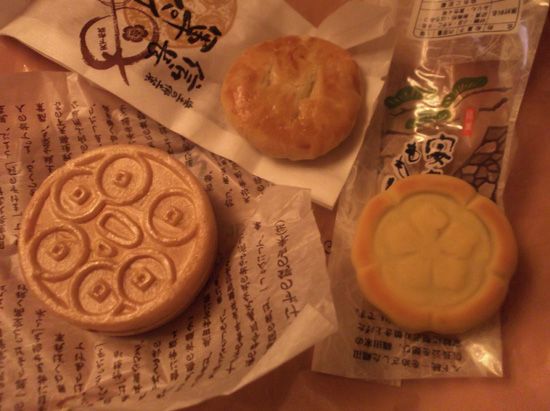I already mentioned the delicious Yumikake Sakura of Mochinobu shop in my short walk in Gifu, but I guessed that my visit to Mangoro, a shop of omiyage and snacks located in Azuchi, deserved a mention too, if not an article.
I was really curious about the culinary masterpieces of this shop, so on a dark afternoon after visiting Amanohashidate, I opted for a detour to Azuchi to get hold of the delicacies.
Here is the booty for the day that I'm going to review right now:


The "Nobunaga Army" of the third pastry refers to the sumo wrestlers that he used to employ as an entertainment in his tournaments of Azuchi Castle.
If you got to know me well enough, by now you shpuld know that I'm not a fan of Japanese sweets, so probably this review may result as a bit unprecise-- Sorry in advance.

The "container" has the consistency and feel of a wafer, but it's generally even more insipid. The contrast between the crispy outside and the dense and soft inside is very interesting.
The Azuchi-Momoyama was the pastry with the best look, but the flavour left me quite perplexed.
Again, the filling is mere red azuki paste, but the dough feels Western in its preparation. Among the ingredients I spotted egg yolk and glutinous floor, and that's probably its result.
The feel in your mouth when munching is quite doughy and dry.... It doesn't go down easily and it's far from pleasant.
Surprisingly, I'd say that my favourite is the Nobunaga-gun Pie: probably it's just because it's a shortcrust, so my Western tastes recognized something like a proper pastry, but even the filling was definitely better, flavoury and pleasant in the mouth. The ingredients specify that the filling is made with azuki from Hokkaido, probably it made the difference?
These aren't the only "Nobunaga-inspired" sweets of Mangoro shops, there is also the Sengoku Tenka Mochi, inspired to the deeds of the three unifiers of Japan and their "mochicious" Realm...


